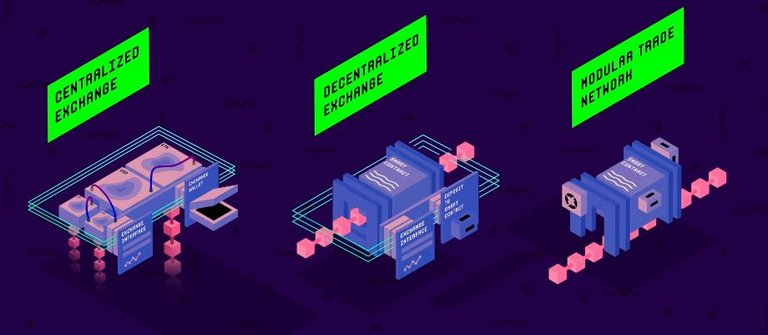Hi, I recently became interested in "Decentralized Exchange" so I've done some searches
and I bumped in this relayer network site, which I thought explains pretty well about such concepts.
from : https://relayer.network/
I've wrote down about the words explained on the video.
(there can be typos... You are welcomed to suggest errors through comments)
It would be better if I could translate this into Korean....
I would try it after I've done more studies related to this area...
Anyways, Exchanges are also becoming decentralized which I find truly interesting!
① Centralized Exchange
A centralized exchange is similar to traditional financial exchange. One entity manages closed liquidity pools holding large amount of tokens in fiat currency. Access to these pools requires an interface and the wallet provided by the exchange. A token owner creates an account and deposits some form of fiat currency. They can then withdraw or trade their currency with the assets available on the exchange. Assets are always held by the exchange. So, if it goes down or closes, a users' funds can be locked inside.
② Decentralized Exchange
A decentralized exchange uses a proprietary interface and smart contracts onboard and facilitate the trading of supported tokens. In this model, users trade directly from their wallet or tokens deposited into the smart contract. The bulk of transactions happen directly on the blockchain. As long as private keys are maintained, assets can always be obtained from the blockchain, even if the exchange disappears. While this is a stepwise improvement from centralized exchanges, this model can present scaling issues from by bloding the network with transactions. It also still requires a centralized entity, to build and maintain the smart contract protocols.
③ Modular Trade Network
The 0x protocol removes proprietary assets from first two models. And separates the bulk of trading action from the blockchain leaving aside of open source smart contracts anyone can plug into. This opens the door for a new system using order relayers. A relayer operates on off-chain orderbug and an interface or an API. Instead of depositing tokens to a smart contract or liquidity pool, a token owners merely create an order and sign it with their private key. The relayer maintains these orders on their book and when orders match, the 0x protocol facilitates the transfer of tokens from one owner's wallet to another.
The interesting part of modular system like this is that multiple orderbooks from different relayers can plug into each other, forming network liquidity. Conversely, multiple niche interfaces can all plug into single orderbook, allowing for mass adoption based on user preferences. Advanced users can broadcast their own orders and trade directly with each other using the 0x protocol (no third party or relayer needed). As the token economy grows, this modular approach opens the potential for entire blockchain ecosystems built on 0x trade protocol allowing multiple dApps, relayers and token owners to transfer assets and utilities between each other fluidly.
Utilizing the ZRX tokens for governance will ensure these modular trade networks will be updated and strengthened through consensus. This will mitigate security risks and create standardized operating methods that can't be created using proprietary centralized models. In the future, when more and more assets become tokenized, modular trade networks will become a foundational tool in developing this new economy.

Congratulations @kylieee! You received a personal award!
Click here to view your Board
Congratulations @kylieee! You received a personal award!
You can view your badges on your Steem Board and compare to others on the Steem Ranking
Vote for @Steemitboard as a witness to get one more award and increased upvotes!